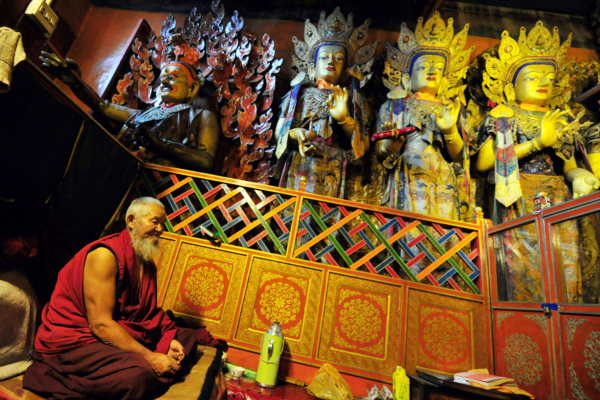Following the relocation of several Tibetan temples in Dege County, Sichuan Province, the Chinese Communist Party (CCP) has once again compelled the Atsok Monastery in Xinghai County, Qinghai Province to relocate under the pretext of constructing a hydroelectric power plant. Now, this Tibetan monastery with a history of 135 years has been forcibly demolished and submerged underwater, serving as another testament to the CCP’s destruction of traditional culture.
Atsok Monastery, established in 1889, was a renowned Tibetan temple in the region where monks and nuns practiced in seclusion throughout the year, as reported by Radio Free Tibet.
Initially designated as a county-level cultural heritage site, Atsok Monastery was deemed unsuitable for preservation by the Xinghai County government in 2023. Subsequently, on September 26 of the same year, the CCP announced the commencement of the “Yellow River Yangqu Hydroelectric Station Project in Xinghai County, involving the demolition and construction at Atsok Monastery.”
In addition to the monastery, several villages near Atsok Monastery were also coerced to relocate, impacting thousands of residents, according to Radio Free Asia.
The Yangqu hydroelectric station is an expansion project of the Yangqu Dam, which was completed in 2010 and began operation in 2016, with a current installed capacity of 1,200 megawatts.
The CCP authorities initiated the demolition of Atsok Monastery in April this year. Satellite imagery experts noted that following the closure of the dam gates around August 10, the reservoir upstream of the Yellow River was filled, leading to a rise in water levels in the region.
Y. Nithiyanandam, the head of the Geographic Information Program at the Takshashila Institution in India, mentioned that satellite images revealed the complete submergence of the 18-hectare area housing Atsok Monastery and an adjacent village, with part of the farmland near another village also flooded.
He further stated that the current water level is approximately 100 meters higher than before, resulting in the submergence of villages. Predicting whether the water level has reached a threshold or will continue to rise remains difficult.
Jacob Bogle, an analyst specializing in satellite imagery, pointed out that the water level reached the height of Atsok Monastery by August 16. By August 31, the entire location of the monastery was submerged.
Tibetans believe the site of Atsok Monastery holds significant spiritual importance. Through 135 years of prayers and generations of spiritual practice, it has become even more sacred.
Despite CCP’s claims of funding the demolition and reconstruction of parts of the monastery, many murals and surrounding stupas couldn’t be moved and were consequently destroyed.
Tibetans have voiced condemnation of the Yangqu hydroelectric station construction, viewing it as another example of the CCP regime disregarding their culture, religion, and environment.
Local Tibetans, fearing retaliation and requesting anonymity, informed Radio Free Asia of their concerns that the dam might trigger further floods, leading to the destruction of their homes and farmland near the neighboring Yangqu village.

